Month: November 2024
Expert Grade Garands
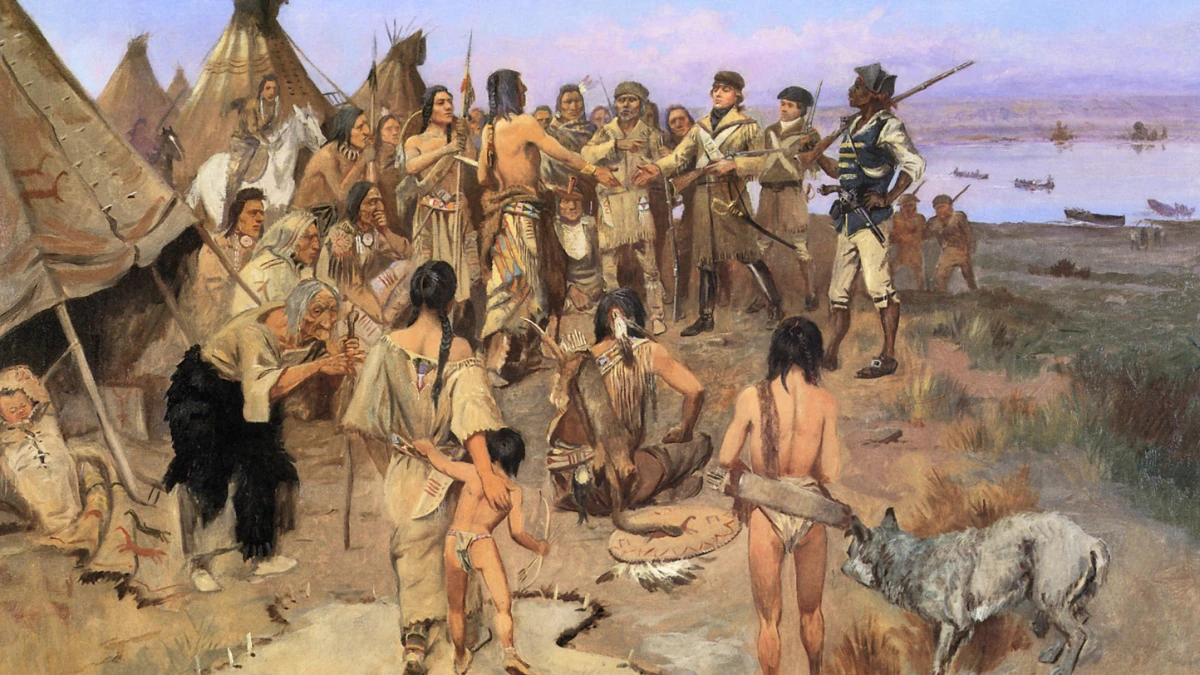 There’s a difference between book smart and bar smart. You may not be book smart, but this series can make you seem educated and interesting from a barstool. So, belly up, pour yourself a glass of something good and take notes as we go under the covers of Lewis and Clark’s famed expedition.
There’s a difference between book smart and bar smart. You may not be book smart, but this series can make you seem educated and interesting from a barstool. So, belly up, pour yourself a glass of something good and take notes as we go under the covers of Lewis and Clark’s famed expedition.
Prior to embarking across the continent with the Corps of Discovery, Meriwether Lewis trained under Dr. Benjamin Rush, whom President Thomas Jefferson considered to be the best physician in the nation. Following the two-week crash course on medicine, Lewis stocked up on over 5,000 doses of drugs, including laudanum to treat coughs, opium to treat pain, calomel to treat worms, and mercury to treat syphilis.
Syphilis was common among the tribes of the Missouri River, and so were sexual encounters with white travelers. Lewis packed accordingly: The mercury was used copiously throughout the expedition.
In one journal entry, Lewis wrote that multiple tribes had a “curious custom” of offering wives and daughters to traders. Plains Indians believed that spiritual powers were passed between people during sex, and that a husband could become a better hunter or more knowledgeable of medicines if his wife had sex with a powerful man, and then had sex with him.
Clark’s black slave, York, was a novelty to the tribes and did as much spiritual power passing as anyone. While visiting the Arikara tribe, a warrior volunteered to stand guard outside a lodge all night while York and his wife were inside. On one evening with the Mandan tribe, York was offered four women.
Other tribes pimped out their women for more worldly possessions. In the Pacific Northwest, multiple groups bartered with sex. One tribe that often visited their camp had a lower price tag than most, Lewis noted. “They do not hold the virtue of their women in high estimation, and will even prostitute their wives and daughters for a fishing hook or a strand of beads.”
That wasn’t all the expedition would leave behind, though. Nine months after the crew departed the Nez Perce in Idaho, an elder’s daughter gave birth to a son that was said to be Clark’s. Similar stories are told by the Teton Sioux, Sioux, and Salish, who claim to have decedents of Lewis and Clark in their tribes.
While some experts question their authenticity, most believe the expedition leaders weren’t exempt from the urges that the rest of the crew acted upon. As my favorite Corps of Discovery historian, Frances Hunter, put it, “I believe that Lewis and Clark were professionals who always put safety, discipline and their mission above everything else. That said, it stretches credibility to think they kept their buckskins buttoned up the whole time.”
Feature image via Charles M. Russel.
_________________________________________________ This expedition also was a major cause on why huge swathes of the Tribes were wiped out by the diseases that the Lewis & Clark troops carried with them. That their European / African ancestors had & of whch they were immune to but not the Indians.
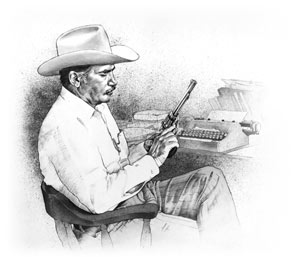
— The Editors
You can make remarks about the ancestry of my dog. Have your doubts about the gas mileage toted up by my family sedan. Spread the story, if you wish, that my backyard barbecues could best be digested by a brood of Arkansas razorbacks. But if you cast aspersions on my .357 Magnum sixgun, get somebody to hold your coat. We’ll continue the discussion in the alley.
I can hoist on his own petard the writer who claimed that the .357 cartridge has never achieved significance as a hunting round. The police brass who deny the usefulness of this gun and cartridge for law-enforcement purposes can be set straight with a few terse observations. Experts who say the load is too powerful and experts who proclaim it is less potent than a river rock from little David’s slingshot will scurry for their ballistics tables if confronted by factual data on the private life of this great load.
It was conceived as a hunting cartridge by Douglas B. Wesson, one of the heirs to the giant Smith & Wesson firm. With the aid of ballistician Phil Sharpe, Wesson discovered that the S&W .38-44 Outdoorsman, a .38 Special mounted on the old .44 Special frame, would withstand extraordinarily high pressures.
This quality was not a mysterious one; it was the simple sum of the thick cylinder walls and modern metals that made up the handsome, target-sighted Outdoorsman.
Sharpe’s handloads, featuring a semiwadcutter cast bullet over a heavy helping of Hercules 2400 rifle powder, gave velocity and long-range accuracy that had never before been realized in a revolver. During the experimental stages, Wesson killed almost every type of North American big game with his brainchild, justifying it as a hunting arm even before it went into production.
The .357 Magnum was formally introduced in 1935, along with a cartridge by Winchester. Bullet weight was 158 grains and diameter .357 inch–same as the .38 Special. The .357 cartridge case was approximately 1/10 inch longer than that of the .38 Special to prevent the more powerful round from being chambered in skimpier .38 Special cylinders.
The Smith & Wesson Magnum was initially offered with a selection of 31„2-, four-, five-, six-, 61„2-, 71„2-, and 83„4-inch barrels. It featured a deluxe, high-polish blue job and checkering along its topstrap and barrel rib. The rear sight, slightly different from the S&W micrometer design of today, was adjustable for windage and elevation by means of opposing setscrews.
A selection of front sight styles was available, including bead insert Patridge types and the then-new sloping Baughman quick-draw model mounted on a King ramp. The action was of the pre-World War II type, which had a longer hammer throw than the short-action S&W revolver of today. A “humpbacked” hammer was offered on a special-order basis and was preferred by many who had difficulty in manipulating the rather small, standard hammer spur.
The first Winchester cartridges were hot as a depot stove, with pressures running higher than 40,000 ft-lbs. Velocity of these powerhouses ran around 1,425 fps when fired from an 83„4-inch revolver, higher in unvented pressure barrels. Today’s factory loadings generally fall short of the initial Winchester offerings, both in the velocity and pressure departments.
The factory .357 cartridge has done a lot to encourage handloading. It is a notorious barrel leader, leaving thick, accuracy-spoiling deposits of bullet metal scabbed up in the rifling after a very few shots. Serious shooters who want to be able to fire long strings without scrubbing the bore after every eight or 10 rounds have turned to putting together their own loads.
These feature well-lubricated cast bullets of extra-hard bullet metal. My favorite answer to the .357 leading bugaboo has been the use of Lyman’s 358156 gascheck bullet, a Ray Thompson design. Properly cast, sized, and lubricated, this semiwadcutter slug approximates the shape of the Phil Sharpe original and sports a copper-shielded base that resists the hot gases of the magnum powder charges. It is an exceptionally clean-shooting, accurate bullet for both light and heavily stoked .357 cartridges.
With this bullet, in both solid and hollowpoint form, I have proven to my own satisfaction that the .357 is a fine hunting pistol. Shooting a variety of Smith & Wesson, Ruger, and Colt magnums, I have killed mule deer and javelina in Mexico, antelope and turkey in Texas. My .357 has put the coup de grace to a great many head of heavy slaughter steers and hamburger bulls, top hogs, sheep, and goats. With proper bullets, I have put ducks, Canadian geese, cottontail rabbits, and bullfrogs on my table.
I once ate a tough old White Leghorn rooster who had the misfortune to be left at an abandoned farmhouse where I made a dry camp. My .357 took his head off.
Turning to varmint hunting, I can testify that the .357 Magnum loaded with hollowpoint bullets offers all the destructive qualities needed at ranges up to 100 yards. Jackrabbits hit solidly with such a load are turned to mush. The plains coyotes I have killed with it have required no second shot when the first was placed anywhere in the thorax or abdominal cavity. One eagle and perhaps a hundred chicken hawks have dropped to my magnum bullets.
And my experience with this cartridge is by no means unusual. My friend, the late Dewey Hicks, was a fine pistol shot and avid hunter. Dewey killed both deer and coyotes with my .357 handloads. He once took an outing with a northern New Mexico rancher. Dewey wanted an elk, but the cowboy was looking for a muley buck for camp meat. He toted a worn, six-inch Smith .357 in a brush-scarred hip holster but was a little worried about his ability to kill a deer with the only loads he had: six rounds of .38 Special wadcutters.
My friend presented him with a double handful of my favorite handloads, made from a recipe of the 358156 hollowpoint bullet held in its lower crimping groove by a Remington .38 Special case. The powder charge was 13.5 grains of 2400 fused with CCI Small Pistol primers. A few hours after loading up with these homebrews, the cowboy tumbled a running buck with a single shot through the spine at 50 yards.
These tall-but-true tales could continue, but for what? Saying the .357 is insignificant as a hunting round is like saying that sourmash bourbon constitutes an unimportant factor in the diet of man. Maybe, but ain’t there lots of it being put to use?
Be sure to check this space again next month for Skeeter’s iron-clad reasoning for his unparalleled fondness for this great cartridge as well as a chart of his best handloads.
My Friend, The .357 (Part 2)
Almost all the objections to the .357 Magnum as a police weapon come from city police departments. It is argued, with some justification, that an officer who fires a magnum in a crowded city is more likely to kill innocent noncombatives than he would be if armed with a standard .38 Special. Not much mention is given to the fact that the same officer runs a hell of a lot more risk of being killed himself when his low-powered .38 fails to put an armed opponent out of action.
The .357 can, when necessary, be loaded down to any desired velocity level that will preclude unwanted penetration and yet offer a very good stopping power with proper bullets.
The Texas Department of Public Safety and the U.S. Border Patrol have accepted the .357 as standard for the patrol officers. Many of these well-trained cops frequently work in crowded, metropolitan areas.
Those that do find it a simple thing to load their magnums with medium-velocity handloads, sometimes with expanding bullets that are good manstoppers but which won’t penetrate dangerously. These thinking cops carry full-powered “maggie” loads in the bullet loops of their Sam Browne belts. If the need arises to stop a car or rouse out a barricaded gunman, they can do it.
I have used many different bullet styles besides the Lyman 358156, although it has remained nearest my heart. A flatnosed semiwadcutter bullet performs best in the .357, especially in heavier loads, and several other good designs are available. In preparing to load for this caliber, some thought should be given to the use of the swaged half-jacket bullets, although I have found them to be generally less satisfactory than good cast bullets, due to their leading qualities and to their greater expense.
The long suit of the .357 is its versatility in handling a wide range of special-purpose cartridges. These range from powder-puff .38 Special target loads to full-powered hunting rounds of up to 1600 fps velocity.
Below is a table of my favorite .357 loads, separated into three categories. The first two sections, light loads and medium loads, can be put up in either .38 Special or .357 Magnum cases. I generally load these in .38 Special cases so they can be readily identified and also because .38 brass is cheaper. The third section, heavy loads, should be assembled in sound, clean .357 cases. While not each is a maximum load, they perform better than any other combinations of the same bullet and powder that I have tried. Bullets used are .357-inch diameter. Velocities are estimated to be those obtained in an 83„8-inch-barreled revolver.
table#specialTable {padding: none;background: black; font-family: Arial,Helvetica, sans-serif;text-align: left;font-size: 11px;}table#specialTable tr {color: red; background:blue;}#specialTable td {margin: 2px; padding: 2px; background: #cccccc; color:black;border-right: 1px solid black; border-bottom: 1px solid black;}#specialTable td.noright {margin: 2px; padding: 2px; background: #adadad;color: black;border-right: none;border-left: none; border-bottom: 1px solidblack;}#specialTable td.noleft {margin: 2px; padding: 2px; background: #adadad;color: black;border-right: 1px solid black;border-left: none; border-bottom:1px solid black;}#specialTable td.noborder {margin: 2px; padding: 2px; background: #669966;color: black ;border-right: none; border-bottom: 1px solid black;}#specialTable th {margin: 2px; padding: 2px; background: #ffffff; color:black;font-family: Verdana, Arial, Helvetica, sans-serif;text-align:left;font-size: 9px;}#specialTable tr.offcolor td { background: #ffffff;}#specialTable tr.footer {}#specialTable td.footer {}#specialTable h3 { margin: 0; padding:0;font-size: 15px; border-bottom: 2pxsolid #669966;}.bottom { 2px solid black;}
Skeeter’s Favorite .357 Magnum Handloads |
|||
|---|---|---|---|
| BULLET | POWDER | VELOCITY | |
| (grs.) | (Type) | (fps) | |
| Light Loads | |||
| Lyman 158-gr. 358156 | 5.3 | Unique | 900 |
| Lyman 150-gr. 357446 HP | 5.0 | 5066 | 950 |
| Lyman 170-gr. 358429 | 3.5 | Bullseye | 850 |
| 150-gr. swaged half jacket | 5.0 | Unique | 900 |
| Medium Loads | |||
| Lyman 158-gr. 358156 | 13.5 | 2400 | 1200 |
| Lyman 150-gr 358156 HP | 13.5 | 2400 | 1250 |
| Lyman 150-gr. 358156 HP | 7.0 | Unique | 1250 |
| Lyman 170-gr. 358429 | 6.0 | Unique | 1150 |
| Lyman 158-gr. 357446 | 5.0 | Red Dot | 1000 |
| Lyman 158-gr. 357446 | 12.0 | 4759 | 1250 |
| 150-gr. swaged half jacket | 7.5 | Unique | 1300 |
| Heavy Loads | |||
| Lyman 150-gr. 358156 HP | 15.5 | 2400 | 1500 |
| Lyman 158-gr. 358156 | 15.0 | 2400 | 1450 |
| Lyman 150-gr. 358156 HP | 15.0 | 4227 | 1400 |
| Lyman 158-gr. 358156 | 8.0 | Unique | 1400 |
| Lyman 150-gr. 358156 HP | 14.0 | Sharpshooter | 1600 |
| Lyman 158-gr. 357446 | 14.5 | 2400 | 1450 |
| Lyman 170-gr. 358429 | 14.5 | 2400 | 1400 |
| Lyman 170-gr. 358429 | 13.5 | H240 | 1350 |
| 150-gr. swaged half jacket | 14.5 | 2400 | 1400 |
| NOTE: All load data should be used with caution. Always start with reduced loads first and make sure they are safe in each of your guns before proceeding to the high test loads listed. Since Shooting Times has no control over your choice of components, guns, or actual loadings, neither Shooting Times nor the various firearms and components manufacturers assume any responsibility for the use of this data. | |||
Since so many varying factors apply to make the results of handloading good, indifferent, or disastrous, neither Shooting Times nor I can be responsible for results obtained by the reader. I can only say that these loads have been safe and useful in my guns.
This list, of course, is by no means a comprehensive selection of .357 loads. It merely represents some that have worked well in my experience. Powder charges listed here may be used with other bullets of the same weight and similar design, but it is well to remember that a plainbase bullet, such as the 357446, will give higher pressures with the same powder charge than the gaschecked 358156. Too, a bullet case of soft alloy will show higher pressures and more barrel leading than one composed of a hard mixture, such as 1:10 tin to lead.
Barrel lengths affect muzzle velocities, but not as much as you may think. Longer barrels do a better job of burning the slow powders necessary for magnum loads, and many hunters buy guns with uncomfortably long barrels in order to squeeze the last foot-second of velocity from their loads.
Tests have shown that in cutting an 83„8-inch-barreled Smith .357 off one inch at a time, only about 35 fps velocity is lost for each inch removed when factory or high-velocity handloads are fired. This means that the shooter who carries an 83„8-inch model that gives 1500 fps would still get 1415 fps out of a six-inch revolver and 1345 fps if he chopped her down to four inches. The game he shoots isn’t likely to know the difference, and the maggie man should pick the barrel length that he can shoot best and carry most comfortably.
In the middle ’30s, the Smith & Wesson was the only sixgun chambered in .357. Colt didn’t seem especially interested in the cartridge but did produce a few Model P single actions in that caliber, along with a sprinkling of New Service and Shooting Master double actions with its .45 frame. These prewar Colts are now collector’s items.
Today Smith & Wesson offers its old original model, slightly refined, as well as a less highly finished version of the same gun, called the Highway Patrolman. Advances in metallurgy have enabled Smith & Wesson to chamber its .38 Special revolver for the .357 cartridge, and it holds forth as the Combat Magnum, filled up with target sights and a heavy, ribbed barrel.
Colt sells sixguns in the form of the old Model P single action and its target-sighted offspring, the New Frontier. The Python, an improved version of the famous .38 Officer’s Model target revolver, is the top gun in the Colt line and one of the most popular .357s used by police. The Trooper is a less fancy version, competing with the S&W Highway Patrolman in price.
Sturm, Ruger & Co. came out with its .357 Blackhawk in 1955, and it is an extremely practical, durable hunting arm. Intercontinental Arms of Los Angeles imports the Dakota, a good replica of the Colt single action from Italy that can be had in .357. Intercontinental also sells a sturdy derringer in the same caliber.
All of these handguns are strong and accurate. At one time or another, I have carried each of them at my side on hunting trips or in law-enforcement work. If I had to choose just one gun to side me for the rest of my life, be it handgun, rifle, or shotgun, I would select a .357 Magnum revolver.
So if you’re in a critical mood, pal, lay off my .357–it’s an old friend of mine.
MGs on Steroids
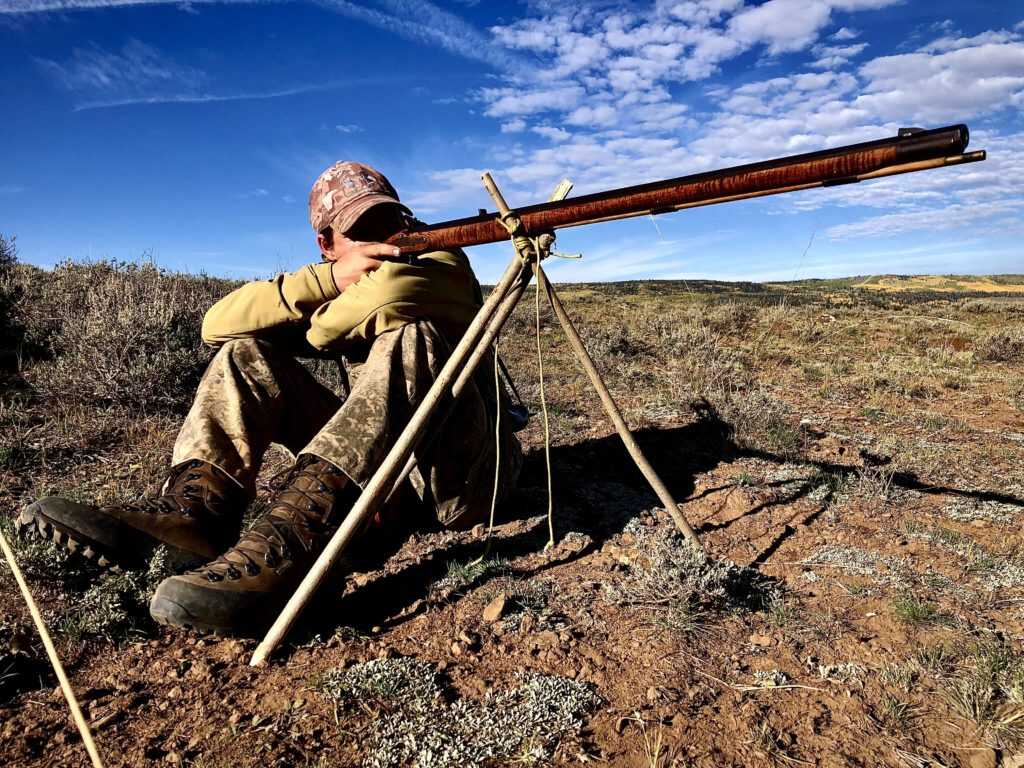
A young hunter stalks within easy range of a big antelope, but the buck is facing him and he’s shooting a 1700s-era patched round ball. Should he take the shot?
As a lifelong hunter, some of my favorite experiences in the field have come while watching and helping youngsters and new hunters learn the ways of the woods. This experience was one of those, yet a little different too. I could see that my 14-year-old son had become a skilled hunter who no longer required my help. It was the first time I haven’t been at his side when he shot a big game animal (though he’s killed lots of coyotes on his own). Let me tell you, it was cool to watch.
RIFLE AND AMMO
Josiah had drawn a Limited Entry muzzleloader pronghorn tag in Utah. Rather than using a scoped modern synthetic-and-stainless inline muzzleloader, he chose to hunt with a traditional .50 caliber long rifle that I made for my wife Trina years ago. It’s a beautiful piece with a 36-inch Green Mountain barrel, Siler caplock, hand-carved trigger, and fixed iron sights. Josiah shot it extensively before his hunt, and when shooting from a sitting position over cross-sticks was lethal out to 125 yards.
The load he used consisted of a 170-grain .490” swaged lead round ball made by Hornady shrouded in a .0018 thick linen patch and seated atop 70 grains of 3F Goex Black Powder. That’s not a super potent load, and I don’t have a velocity to share with you, but it shot very accurately and surprisingly flat out to 125 yards.
For optics, Josiah was using one of Leica’s new Geovid Pro 32 Binocular/Rangefinder units in 10X32 power. I watched from a distance through an old Zeiss spotting scope. I filmed the hunt on my phone through that spotter with the use of a Phone Skope attachment.
THE HUNT
The pronghorn unit Josiah had drawn features high-elevation rolling sage flats and swales, broken by timbered draws and ridges. It’s a ways from the nearest town, and the roads aren’t very good. A busy summer hadn’t left us any time to scout, but I’d hunted the area before and knew where the antelope like to hang out and how they like to travel. On the afternoon before the opening day, our truck groaned and complained as we eased along a rough two-track, working our way into a secluded campsite in the heart of our hunting area. Josiah counted roughly sixty pronghorn en route, including several nice bucks.
We talked about his goals for this hunt, and both agreed that considering the fact that he was hunting with one of the most primitive weapons available, and that pronghorn antelope are notoriously difficult to stalk, he should shoot the first nice buck he had a good opportunity at. We expected it to take several days and many stalk attempts before he managed to close within his effective range.
We set up camp in a patch of timber, pitching our tent and gathering a pile of firewood under a tarp against an anticipated rainstorm. Josiah began to ready his muzzleloader and gear to hunt the next morning. That’s when he discovered that he’d left home the Bog Pod shooting sticks he’d done all his practicing with. We both stomped around and growled for a minute, but then he cut a couple of finger-sized saplings and fashioned them into a set of cross-sticks. He was ready to rock and roll.
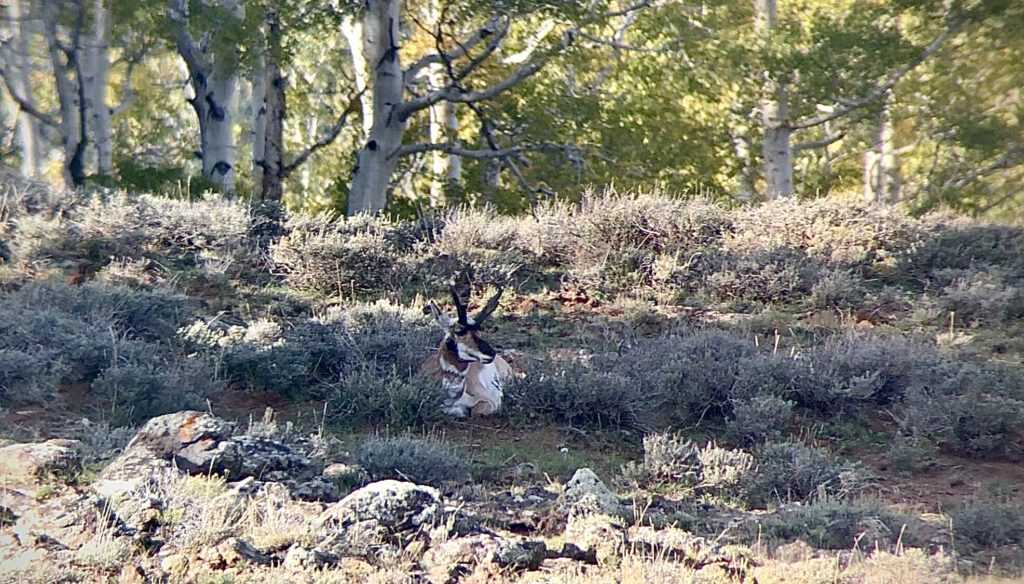
Daylight found us moving slowly toward a big swale where we’d seen a big buck tending his harem the night before. Good shooting light had just arrived when we spotted four pronghorn in the distance, one of them a really nice buck. They moved out of sight across a low ridge, and the stalk was on.
The antelope split up, with three disappearing down a draw and the fourth – the big buck – feeding up the opposite side of a gentle swale. Whenever he put his head down to feed we would move closer, keeping together and trying our best to look like a beef cow feeding in the sage.
More than an hour passed and the buck finally bedded, 265 yards away with no cover at all between us. Had Josiah been hunting with a modern rifle or even a modern muzzleloader his hunt would have been over right there, but with a primitive muzzleloader, it was just the beginning of the stalk.
Sometimes antelope are very curious and can be “flagged” in with a white handkerchief or similar, so we hunkered down and waved my yellow silk scarf above us. The buck was interested but seemed more calmed by the sight than stimulated. I attribute this to the scarf being similar in hue to a pronghorn’s side, and I believe the movements made the buck think another antelope was feeding at our position.
Time passed, and eventually, Josiah decided to try to stalk across the intervening swale and close within shooting range of the buck. He mimicked an animal feeding and kind of meandered in the general direction of his quarry on all fours, pretending to stop and feed along the way. It worked; the buck ignored him most of the time. Whenever he became nervous I would wave the yellow scarf and he would relax and resume chewing his cud.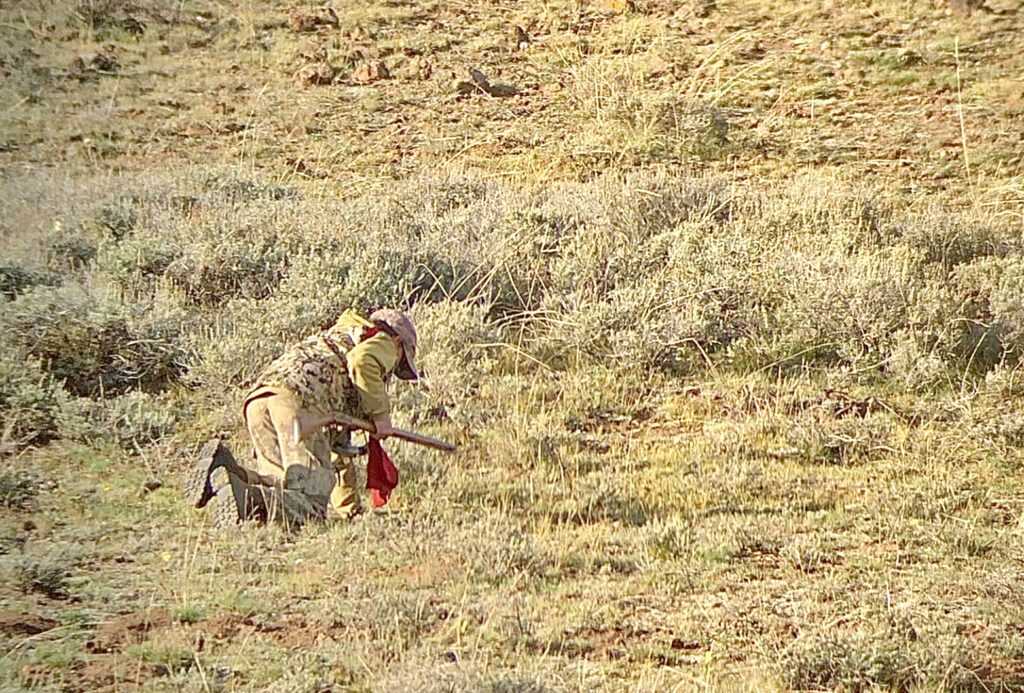
Josiah managed to crawl to just under 100 yards of the buck and set up his shooting sticks. He didn’t have a shot because the buck was bedded, and I saw him looking back at me. He told me later he considered waiting there till the buck moved and gave him a shot, but decided to stalk closer because it would be more fun and challenging. Crawling slowly, he managed to keep under cover of the low sage and a few rocks and closed to 50 yards. I was on pins and needles while watching, amazed that he was getting so close to the buck. Finally, he sat up, rested his rifle across his homemade shooting sticks, and whistled. I knew then that he needed the buck to get up before he had a clean shot at it. I stood up and let the antelope see me, and then made my best rendition of a coyote howl. That did the trick; the buck stood up and stared in my direction. He was facing dead-on to Josiah.
WOULD YOU TAKE THE SHOT?
Put yourself in Josiah’s shoes; after practicing all summer with your primitive rifle you’ve traveled 500 miles, slept on the ground, and then managed to stalk within easy range of a big pronghorn buck on the first stalk of your very first day. It should be an easy shot, but the buck is facing you dead on. What are you going to do – will you take the shot?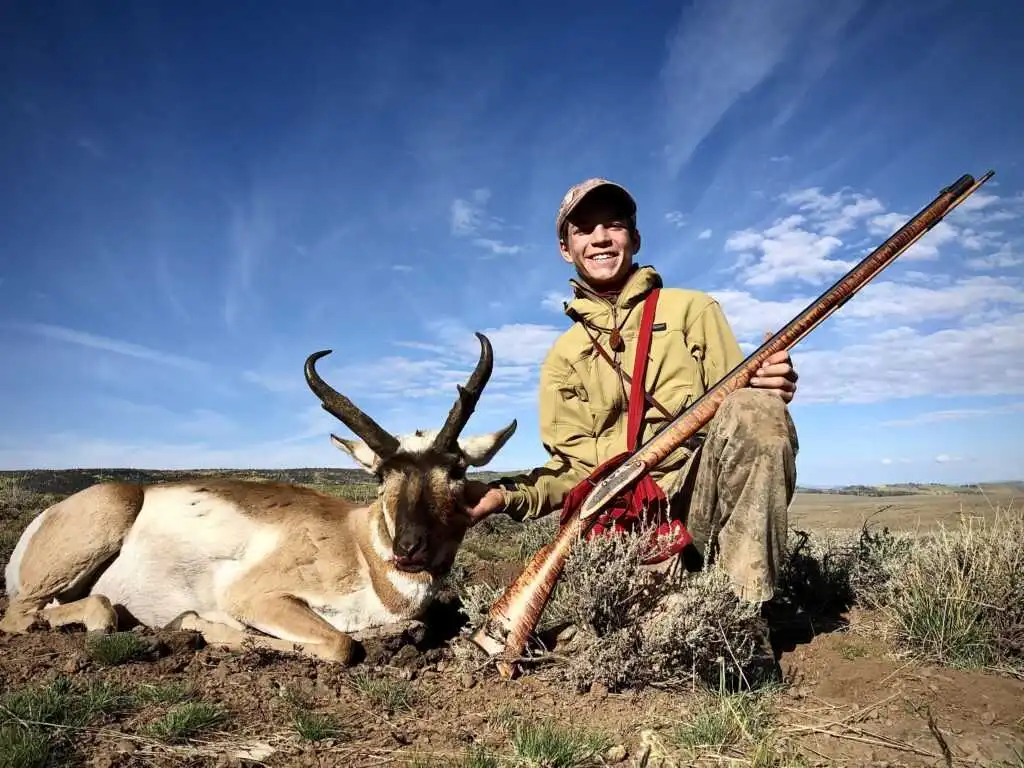
HERE’S WHAT HAPPENED: TRUE STORY
From his sitting position with the long rifle rested across his shooting sticks Josiah could only see the tips of the buck’s horns 50 yards away. He whistled to try to get the buck to stand, with no response. Then I made a coyote howl and the buck stood, fully alert. Josiah placed the iron sights on the buck’s chest and squeezed the trigger. You can watch the result in the accompanying video – it’s spectacular. The round ball entered the buck’s chest and exited through its backbone, dropping it in its tracks.

CONCLUSION
Josiah worked hard to be ready with that primitive rifle, choosing to hunt with it rather than a modern muzzleloader because of the extra fun and challenge it offered. He’s a very good shot and has exceptional eyesight, which enabled him to be lethally accurate with the iron sights. And he executed a perfect stalk, putting him within easy range with the old smoke pole.
